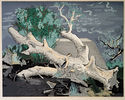
19th, 20th & 21st Century Fine Prints
707-546-7352 · fax 707-546-7924 · web: www.annexgalleries.com · email: artannex@aol.com
Guy Crittington Maccoy Biography
Guy Crittington Maccoy
American
1904–1981
Biography
Serigrapher, painter, and muralist Guy Crittington Maccoy was born on October 7, 1904, in Valley Falls, Kansas. He began his art studies at the Kansas City Art Institute, taking both day and night courses from Thomas Hart Benton, Randall Davy, Vaclav Vytlacil, and others. Following this, he moved to Colorado Springs to attend Broadmoor Art Academy. Awarded a Tiffany scholarship in 1929, he moved to New York City to continue to study and work as an artist, focusing on mural painting and printmaking.
In 1930 he was awarded a scholarship with the Art Students League, where he worked alongside such artists Jackson Pollock and Rico Lebrun. By this time, Maccoy had established a reputation as a leading fine art silkscreen printmaker (now sometimes credited with popularizing silkscreen as an original art form on its own, removing it from its relegation as a commercial-only technique). He began taking commissions for reproducing other artists' works, with the intent of helping artists earn extra income as the Depression began to take hold.
In 1933 he left the Art Students League to work for the WPA, for whom his wife, Geno Pettit, worked as a supervisor. He enrolled as a muralist, designing the murals for the Central American Arts and Girls Industrial High School, and in 1934, he was commissioned by New York mayor La Guardia to help develop a series of posters for the city. Meanwhile, he experiemented with different mediums and techniques to create the works he dubbed "serigraphs," creating intricately designed, multi-screen works that eventually earned him his first solo exhibit in 1938 at the Contemporary Art Gallery.
Maccoy graduated from Columbia University in 1939 with a BA in teaching, courses he took while working with the WPA. Upon graduation, he was offered a position at the Poligraphic Lithographic Company in Vermont. After relocating, he and Pettit helped to found "The Workshop," a precursor to the National Serigraph Society, which worked to establish silkscreen as a legitimate fine art. When he and Pettit moved to Los Angeles in 1945, many of the artists in the organization followed; Maccoy remained a member until 1947, when he formed the Western Serigraphy Society. An offer to teach at the Otis Art Institute in 1949 by Millard Sheets heralded a lengthy teaching career for Maccoy throughout the 1950s and '60s, including positions at the University of California, Los Angeles and the Palos Verdes Art Center. After retirement in 1965, he would continue to teach private lessons and workshops.
A fire in 1970 destroyed the entirety of Maccoy's home and studio, just weeks after his insurance was revoked due to living in a fire prone area in the Santa Suzannah mountains. Every work of art that was not kept in a gallery or private residence was lost, and he no longer had the means to rebuild. Rallying friends and fellow artists helped Maccoy form Guy Maccoy Studios in Canoga Park and, in 1972, a second studio for teaching workshops and taking on commissioned reproductions under the label Limited Edition Serigraphs. Employing a small, skilled team of artists who had worked with Maccoy in the past, he would reproduce works using up to 100 plus color runs, producing his famed layered, painterly effect. He continued his work in oils, watercolors, and other mediums as well.
Maccoy remained active until his diagnosis with ALS in 1979. Eight months later, he died in Los Angeles on March 18, 1981.
Collections: Metropolitan Museum of Art, Philbrook Museum of Art, New York Public Library, Library of Congress. Murals: Brooklyn Museum; Girls' Industrial School (Brooklyn) to name a few.





